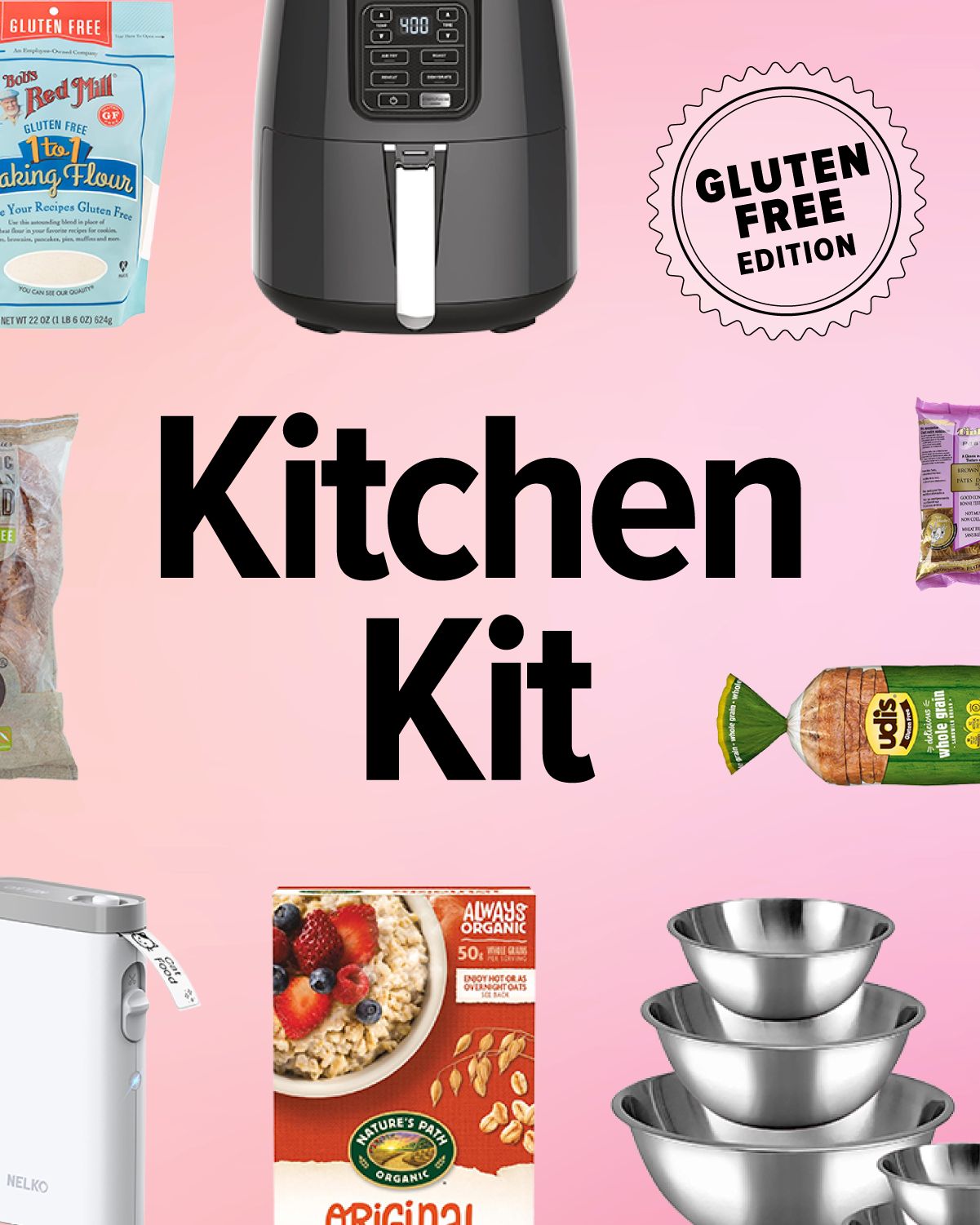Key takeaways
- Creating a gluten-free kitchen may seem a daunting task, but we spoke with a registered dietitian to create a simple, step-by-step guide.
- Our gluten-free teammates at Healthline also give their tried and tested tips and recommendations.
- To create a gluten-free kitchen, begin with a deep clean, then make food swaps and consider separate kitchen equipment.

Kelli McGrane is a registered dietitian, cookbook author, and longtime Healthline contributor. She’s on a mission to prove that eating healthy can be stress free and simple.
In this article, she shares some tips for creating a safe and healthy gluten-free kitchen, considering everything from key food swaps to handy gadgets.
Registered dietitian Kelli McGrane, MS, recommends a deep clean as your starting point.
“The best place to begin is by taking everything out of your cabinets, drawers, fridge, and freezer and giving those spaces a deep cleaning. While not as obvious as a loaf of bread, shelves and drawers can collect crumbs over time and are a sneaky source of cross contamination.”
“Once surfaces are clean, the next step is to get rid of any food items, appliances, or utensils that may contain gluten or increase the risk of cross contamination. From there, you can slowly start to add gluten-free-friendly items and products.”
Our team’s recommendations
Senior Editor Allie Toren has been gluten-free for about 15 years. She gave us her tried and tested tips and recommendations:
“Going gluten-free can be overwhelming, but it’s totally doable once you learn the basics. Now is the best time in history to be gluten-free, because there are so many safe foods out there (at the grocery store and at restaurants), and most people actually know what gluten is.”
“Keep in mind that gluten hides in places you don’t expect, like soy sauce, seasoning mixes, vinegars, and anything smoke-flavored (barley and malt are often used to get the smoke flavor). Just be sure to always check the label.”
Allie notes that while gluten-free replacements are convenient, they may not be the healthiest option.
“In general, try to eat naturally gluten-free, unprocessed whole foods rather than gluten replacements. Gluten replacements are usually chock full of sugars and gums that can upset a sensitive stomach. Obviously, sometimes I just need a cookie or a sandwich, but in general, I try to eat gluten-free without the processed foods. It’s hard! But I feel so much better overall when I’m successful at this.”
Allie’s final tip? “Always, always toast GF bread. It makes a huge difference!”
After the cleaning is complete, you can dive into the world of gluten-free food swaps. Begin with pantry staples such as flour, bread, and pasta, then focus on products that may contain “hidden” gluten, such as snacks, sauces, and drinks.
Our dietitian McGrane notes that, aside from obvious sources of gluten such as bread and flour-based snacks (like crackers), you should also look for unexpected sources.
“Once you start reading labels for gluten-containing ingredients, you’ll be surprised just how often you stumble across products that aren’t gluten-free. Condiments are a sneaky source of gluten, including flour, malt, and wheat starch. Other unexpected sources include processed meats, meat alternatives (like frozen veggie burgers), protein and breakfast bars, baked beans, salad dressings and condiments, and ice cream.”
It is also important to consider drinks. Some alcoholic drinks, such as beer, contain gluten. Most soft drinks are gluten-free, but always check labels to make sure.
While there are many gluten-free alternatives and swaps available nowadays, McGrane warns that these may not always be the healthiest option.
“In general, I’d caution that just because something is gluten-free, it doesn’t mean it’s necessarily healthy. As with any food, regardless of whether gluten is present, it’s important to look for products with relatively short ingredient lists and little, if any, artificial additives and preservatives.”
To start with, consider making swaps for kitchen staples. Our gluten-free teammates at Healthline recommend the following:
For some people, meal delivery services may be the ideal option for a gluten-free kitchen. It can help save time and energy when finding gluten-free recipes and sourcing ingredients — it’s all done for you.
One downside of meal delivery is the cost — it’s typically more expensive than buying your own groceries and cooking from scratch. However, the convenience may be worth the price if you’re pressed for time or energy.
Some brands offer both meal kits and prepared meals. You may like to combine these services, receiving regular meal kits when you want to cook and keeping prepared meals on hand as a quick and convenient option.
We’ve listed our favorite gluten-free meal delivery services below.
After stocking up on gluten-free foods, it’s time to consider the kitchen equipment you use.
McGrane emphasizes the importance of having separate kitchen tools and appliances where cross contamination is a risk.
“From toasters and waffle irons to pots, pans, and colanders, there are many opportunities for cross contamination in kitchens where gluten-containing foods are prepared.”
“For kitchens where gluten-containing ingredients will be prepared, it’s important to have designated tools and appliances for gluten-free foods. This includes appliances like air-fryers as well as everyday tools like baking sheets, pots, pans, colanders, wooden utensils, etc.”
One unexpected tool that McGrane recommends for managing allergens in the kitchen? A label maker.
“For setting up a gluten-free environment, investing in a label maker can be more helpful than you might imagine. By clearly labeling appliances, tools, or even areas of your kitchen (such as a certain utensil drawer or shelf in the pantry) as gluten-free, it can help the whole household ensure your kitchen is a safe space for those following a gluten-free diet.”
Our teammate’s recommendations
One Healthline contributor, who asked to stay anonymous, said they have been gluten-free for 4 years to manage irritable bowel syndrome (IBS) symptoms.
“My brother has a gluten intolerance and has been gluten-free for over a decade, so I figured I’d give it a shot. It has seemed to help, so I kept it up.”
They agree that having separate utensils for gluten-free food prep is essential when cross contamination is a risk.
“It becomes trickier when there’s someone with a gluten allergy in a household of others who do consume gluten. In that case, I would recommend certain pots, pans, spoons, etc, are only used for gluten-free recipes. And keep the bags of GF flour and regular flour separate from each other.”
“Having premade meals and meal kits is also reassuring. You know it is completely gluten-free, and it saves time.”
Below, we’ve listed some kitchen equipment that you might want to stock up on for your gluten-free kitchen:
While not an obvious part of most kitchens, McGrane notes that supplements are a potential source of gluten.
“Perhaps the most surprising source for many people is medications and supplements. Gluten may be used as a filler or coating, making it essential to look for products that specifically say they’re gluten-free. Ideally, look for gluten-free certifications.”
McGrane is also keen to emphasize the importance of considering nutrition when creating a gluten-free kitchen.
“With a gluten-free diet, it’s important to ensure that you’re still following an overall balanced diet with plenty of variety. Because gluten is found in numerous foods and products, gluten-free diets can be overly restrictive. In fact, research shows that gluten-free diets tend to be deficient (or inadequate) in protein, iron, selenium, zinc, and B vitamins like niacin and folate. For this reason, it can be helpful to work with a registered dietitian to ensure your nutritional bases are covered when removing gluten from your diet.”
To make a kitchen gluten-free, beginning with a deep clean can help remove any potential gluten on surfaces and equipment.
Stock only gluten-free foods and ingredients, and consider gluten-free meal delivery services.
If using a kitchen for both gluten-containing and gluten-free foods, ensure they are kept separate and thoroughly clean all equipment and surfaces after handling gluten. If possible, use separate areas and equipment for gluten-free food storage and preparation.
While gluten-free snacks and staples are convenient, they may offer little nutritional value. Consider eating whole foods when possible, including fruits, vegetables, healthy fats, and plant proteins.
A gluten-free diet can be restrictive, so eating a balanced and nutritious diet is important. Consider a gluten-free multivitamin if deficiencies are a concern.
Wheat, barley, rye, and triticale are key ingredients to avoid in a gluten-free diet. Malt and brewer’s yeast are also common sources of gluten.
These ingredients often appear in pasta, bread, noodles, cereals, and baked goods.
It’s important to read ingredient labels carefully. Some products, such as oats, do not naturally contain gluten but are often contaminated during processing.
Creating a gluten-free kitchen may seem daunting, but if you focus on one step at a time, it’ll soon come together.
Your first step should be to thoroughly clean and sanitize the kitchen before stocking it up with gluten-free swaps and pantry staples.
If there is a risk of cross contamination, having separate cutlery and cookware for gluten-free cooking is a smart move. Separate storage and cooking areas can offer further reassurance. If this is not possible, careful cleaning of surfaces and equipment before preparing gluten-free food is essential.





